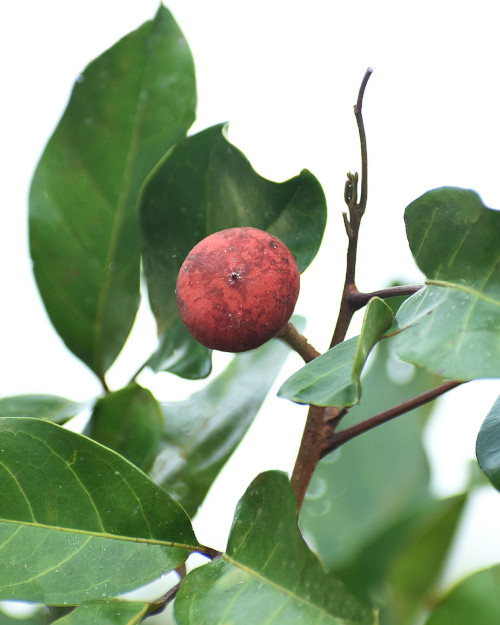July 14, 2025
You may have heard of the Sentul area in West Java – a verdant, rolling landscape of golf courses and suburban housing developments on the outskirts of Bogor, interwoven with tea plantations and patches of forest. But did you know there’s another kind of sentul? It’s rooted in very different surroundings, in the peatlands of Riau in South Sumatra.
Sentul fruit in Riau comes from the sandoricum beccarianum tree, which grows naturally in the lowland forests and mineral soil. At Restorasi Ekosistem Riau (RER) this fruit, and the tree from which it grows, are among the many species of flora under our protection. In West Java, this tree’s close relative is sandoricum koetjape, also known as ‘kecapi’.
In this article, we take a closer look at the original sentul, to reveal its unique characteristics, its role in forest ecosystems, and the actions being taken to secure its protection in the wild. So next time you’re taking a swing on the fairways of Sentul area outside Bogor, remember there’s a different kind of green behind the scenes, from which this leafy and refreshing region of West Java took its inspiration.

From Discovery to Recovery: The Story of Sandoricum Beccarianum
Named in honor of renowned 19th-century Italian botanist and explorer Odoardo Beccari, sandoricum beccarianum is an upper‑canopy tropical tree that grows in peat swamp and mixed lowland forests across Peninsular Malaysia, Sumatra, Borneo, and parts of Peninsula Thailand. A member of the Meliaceae family, it grows to heights of around 10-42 meters, with a trunk of up to 75 cm in diameter.
The sentul fruit which grows from sandoricum beccarianum in Riau is a small, round drupe measuring 2-6 cm, which appears orange‑red to pinkish‑yellow when ripe, and is known for its juicy, sweet‑sour pulp. By comparison, sentul fruits from kecapi are larger and more palatable for humans. For generations of communities foraging in the forests of West Java, this fruit has provided a fresh snack during journeys, but it can also be picked and carried home to be used in jams, beverages, desserts, and condiments.
Fruits of the Forest: A Closer Look at Sentul
The smooth-skinned fruits of sandoricum beccarianum are round or slightly oblong in shape. The trees’ flowers grow in small, fragrant clusters (yellow‑green to white), which attract stingless bees (kelulut) and various other forest pollinators. Flowering usually begins after around 5-7 years (or 3-4 years in some grafted plants), which is triggered by the formation of new shoots. The fruit then ripens over a period of around 2-5 months, depending on species and location.
The sentul fruits provide a source of food for various forest animals, including bats, birds, and primates like the siamang gibbon and macaques. Creatures who consume the fruit then repay the trees’ generosity by dispersing its seeds in their droppings as they roam the forest. One of the tree’s most regular customers is us – in Indonesia and Malaysia, people eat the fresh pulp raw, sometimes with seasonings; whereas in the Philippines, the rind of sandoricum koetjape is cooked in coconut milk with pork and pepper to create a dish called sinantolan, and the pulp is also used in sour soups like sinigang.
Sandoricum beccarianum: Forest Sentinel, Community Storehouse
Sandoricum beccarianum trees occur naturally in lowland forests, making the RER restoration area their perfect habitat. Here, the trees provide shade by closing the forest canopy, while also providing a source of food and shelter for a wide range of wildlife.
For people too, the trees offer a range of benefits. In years gone by, the straight boles were used for construction and furniture, while the fruits are known to provide a range of culinary applications and medicinal benefits too. The bark, roots, and leaves are used in various traditional Indonesian herbal remedies to combat ailments such as diarrhea, fever, and menstrual cramps; root decoctions have been known to effectively treat stomach issues, and fruit peel extracts contain antibacterial and anti-inflammatory qualities.
With so many potential applications, and a ubiquitous role in daily life, sandoricum beccarianum has developed a strong resonance in Indonesian culture – a status that’s reflected in everything from prescriptions and ingredients to road signs and place names.
Restoration, Recovery & Protection at RER
Considering the important ecosystem role and cultural value of sandoricum beccarianum, restoration efforts at RER take on a new significance, both for people and nature. RER currently operates a total of nine nurseries, with seven on the Kampar Peninsula and two more on Padang Island. The largest nursery can be found in the former location, and is capable of housing up to 25,000 seedlings at a time. These seedlings come from three sources in the surrounding natural forest: uprooted seedlings, seeds that have fallen from forest trees, and cuttings carefully and selectively taken from mature trees.
Annual RER restoration targets include 400 trees per hectare at 5×5 m intervals, with six‑month follow‑up checks to monitor success rates and inform planning for subsequent replanting initiatives. In addition to being grown in the Padang Island nursery, S. beccarianum also occurs naturally in lowland forests on Riau – through general preservation and monitoring of these areas, RER is helping to ensure such species can survive and proliferate naturally, free from common threats such as fire, deforestation, and unsustainable resource utilization.